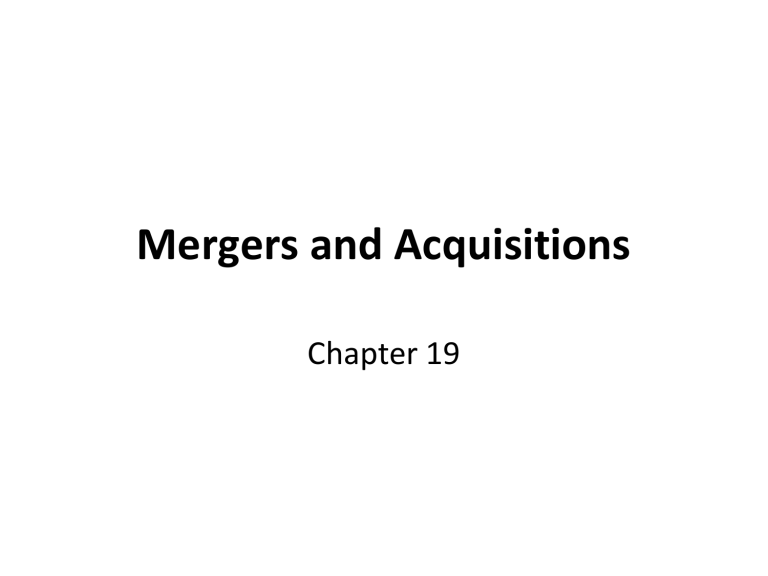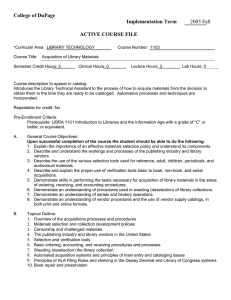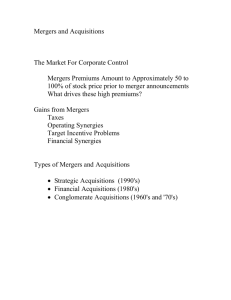
Mergers and Acquisitions Chapter 19 Mergers and Acquisitions • Corporations strive to increase their earnings per share over time. • Methods – “Organic” approaches: • Increase sales of existing divisions while maintaining level operating margins • Increase operating margins with constant sales – Mergers and Acquisitions: • Seek to merge or acquire another corporation, with resulting corporation’s size and earnings enhanced by combination A Brief History of Mergers and Acquisitions • M&A transactions date back to 19th century • Horizontal acquisitions: acquiring competitors in the same industry and then systematically reducing costs of acquired company by integrating its operations into acquirer's company • Vertical acquisitions: acquiring companies in own supply chain • Enormous trusts, or business holding companies A Brief History of Mergers and Acquisitions • In the 1920’s, 1960’s, and 1980’s, M&A activity reached historic highs and corresponded to positive performance of the stock market. – 1920’s: combinations of firms within industries – 1960’s: conglomerate approach (e.g. LTV, ITT) – 1980’s: use of large amounts of debt as the means to finance acquisitions of companies with cheaply priced assets through leveraged buyouts A Brief History of Mergers and Acquisitions • In the 2000’s, Wall Street declined due to lower asset values and increased government regulation; strategic horizontal mergers are becoming more common. – Strong banks are absorbing weak ones before/after FDIC seizes them. – Chemical, pharmaceutical and commodities firms are merging in order to increase global reach and reduce cost per unit of production. – Leveraged buyout firms (now private equity firms) have decreased their activity due to losses from 2007/2008 vintage investments and reduction in debt availability. – Completed deals have lower levels of debt and therefore, either a lower price or more equity. How Companies Can Work Together • Article 2 of the Uniform Commercial Code (UCC): set of contractual rules for sale of goods between companies • Vendor-customer relationships are governed by purchase orders (POs): short form of contract, containing standard provisions and blank spaces for price, quantity, and shipment date of goods involved How Companies Can Work Together • Strategic alliance (or teaming agreement): parties work together on a single project for a finite period of time – Do not exchange equity – Do not create permanent entity to mark relationship – Written memorandum of understanding (MOU): memorializes strategic alliance and sets forth how parties plan to work together How Companies Can Work Together • Joint venture: parties work together for lengthy or indeterminate period of time – Form new, third entity – Divide ownership and control of new entity, determine who will contribute what resources – Advantage: two entities can remain focused on their core businesses while letting joint venture pursue the new opportunity – Downside: governance issues and economic fairness issues create friction and eventual disbandment How Companies Can Work Together • Acquisition: acquired company becomes subsidiary of purchasing company – Most permanent – Eliminates governance and economic fairness issues – Forms of acquisitions • Merger • Stock acquisition • Asset acquisition How Companies Can Work Together • Merger: two companies legally become one • All assets and liabilities being merged out of existence become assets and liabilities of surviving company • Stock acquisition: acquired company becomes subsidiary of acquiring company • Asset acquisition: assets but not liabilities become assets of acquiring firm How and Why to do an Acquisition • If acquisition will create positive present value when weighing outflow (acquisition price) versus future inflow (cash flow of acquired company plus any synergies), then transaction makes financial sense. – Difficulty: determine what exactly are the outflows, inflows, and synergies (both revenue/cost synergies) How and Why to do an Acquisition • Common synergies • Cost Savings: – – – – One has lower existing costs due to efficiency, scale, etc. One has better cost management Combined company has greater economies of scale One has better credit rating/balance sheet and therefore cheaper financing costs – Transactions costs eliminated in vertical merger – Reduction in employee costs (layoffs) – Reduction in taxes if acquirer has NOLs and is not limited by Section 382 of IRC How and Why to do an Acquisition • Common synergies (continued) • Revenue enhancements: – Use of each other’s distributors and other channels – “Bundling” opportunities from combined product offering makes company more attractive – Combined company can raise prices (greater market power) How and Why to do an Acquisition • Companies will hire a group of advisors to assist in evaluating and consummating transaction investment bank, law firm with expertise in mergers and acquisitions, accounting firm, valuation firm How and Why to do an Acquisition • Investment bank • Primary financial advisor • Puts together financial model to analyze cash flows of combined company on pro forma basis • Evaluates comparable transaction in order to render advice on price • Offers advice on tax and accounting structure for transaction • Helps raise capital needed to complete transaction How and Why to do an Acquisition • Law firm – Responsible for drafting and negotiation of transaction documents – Reviews appropriate tax, employment, environmental, corporate governance, securities, real property, and other applicable international, federal, state and local laws – Advise Board of Directors on fulfilling its fiduciary duties of care and loyalty to shareholders How and Why to do an Acquisition • Accounting firm – Advise company on proper tax and accounting treatment of transaction – Assist in valuing certain specific assets – “Comfort letter” on certain accounting issues – Consent letter needed if publicly registered securities offering is made in connection with transaction The Politics and Economics of Acquisitions • Key political elements of a transaction 1. Which entity will survive or be parent company 2. What will new company’s board of directors look like 3. Who will manage company day-to-day The Politics and Economics of an Acquisition • Smaller company will typically become subsidiary of larger company – Smaller company may have token representation on Board of Directors of parent – Management of smaller company will typically either remain at subsidiary or exit The Politics and Economics of an Acquisition – Merger of Equals • Board positions often allocated 50/50 • “Office of the Chairman” or “Office of CEO”: formed to share management authority • Murky lines of authority or shared power can lead to difficulty and conflict The Politics and Economics of an Acquisition • Buyer will offer price based on whether transaction will be accretive: increases earnings per share of acquiring company • Seller will seek premium over its existing stock price (if public) or price in line with public traded comparables or recent public disclosed M&A transaction multiples based on price to earnings, price to EBITDA or price to sales (if private) LBOs, Hostile Takeovers and Reverse M&A • Leveraged Buy Outs (LBOs): purchases of stock of company where a significant percentage of purchase price is paid for with proceeds of debt – Became prominent in 1970’s and 1980’s with rise of LBO shop – Debt financing to fund: • High yield (junk) bonds • Hostile takeovers: acquisition in which “target’s” board of directors does not consent to transaction – Tender offer: Potential buyer or “raider” makes cash offer directly to shareholders, thereby bypassing board of directors LBOs, Hostile Takeovers and Reverse M&A • Three major events altered landscape to reduce incidence of hostile takeovers: 1. Creation of poison pills: companies issued convertible preferred stock to exiting shareholders with provisions which made a potential tender offer prohibitively expensive 2. State of Delaware passed new provision of Delaware General Corporate Law, Section 203: requires hostile buyer to acquire at least 85% of target company in order to consummate hostile takeover 3. U.S. Congress passed revision of tax code: limited tax deductibility of certain high yield debt (HYDO rules), thus reducing attractiveness of junk bonds as means of financing acquisitions LBOs, Hostile Takeovers and Reverse M&A Reverse M&A (add value through divestiture) • Four forms of reverse M&A: 1.Simple sale of division or subsidiary: asset sale, stock sale, or merger LBOs, Hostile Takeovers and Reverse M&A 2. Spin-off: corporation issues dividend of shares of subsidiary to be spun-off corporation’s shareholders – Shareholders of parent participate in spin-off on pro rata based on their ownership percentage in parent – Prior to spin-off, parent may extract cash from subsidiary • “19.9% IPO”: subsidiary is taken public and all or large portion of proceeds are then allocated to parent • Transfer certain debts to subsidiary so that parent ends up with less leveraged balance sheet post spin-off • Parent has subsidiary dividend to parent a portion of subsidiary’s cash LBOs, Hostile Takeovers and Reverse M&A 3. Split-off: shareholder in parent corporation elects to take shares in subsidiary being splitoff, but ends up with fewer shares of parent corporation 4. Split-up: shareholder elects to take shares in one part of split company or other – Less common than spin-offs and split-offs because most shareholders like having parts of both parent and entity divested





